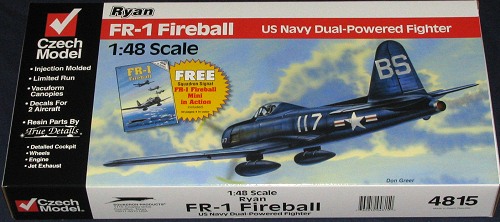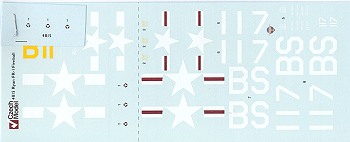
| KIT: | Czech Model 1/48 Ryan FR-1 Fireball |
| KIT #: | 4815 |
| PRICE: | $39.95 (35.96 at Squadron) |
| DECALS: | Two options |
| REVIEWER: | Scott Van Aken |
| NOTES: | Multi-media kit with resin parts and vacuformed canopy |

| HISTORY |
Navies have generally been pretty conservative about things that this was especially true in the first half of the 20th Century when it came to aviation. What was needed in a carrier aircraft was reliability above all. It was not a good thing to be flying far from any landing space and have your airplane start giving you trouble. It was also a requirement that the aircraft be able to land at a fairly slow speed as deck space wasn't infinite. The lead to most carrier borne aircraft being somewhat lower in overall performance than those designed to operate from land bases.
With the coming of turbine power, the Navy was in a bit of a quandary. It wanted to exploit this new propulsive force, but was really concerned about the reliability of these engines. The best thing to do would be to combine the reliability of the air cooled radial with the power of the turbojet. In this mode, a requirement for a dual powered aircraft was put forth in 1943. The result was the Ryan FR-1 Fireball, an aircraft with a reliable 1,350 hp Wright Cyclone and an unreliable 1,600 lb thrust GE J-31 turbojet.
The first prototype flew without the turbojet in mid 1944 and was used for general airframe handling and carrier suitability trials. The airframe was conventional as you can get and proved to be a pleasant aircraft to fly. It did provide some innovations to carrier planes aside from the turbojet. For one thing, it had a laminar flow wing and it also had a nose gear, something not normally seen on a carrier aircraft. The first planes were delivered to the Navy in January 1945 and a concerted effort was made to get the planes into combat where the extra thrust from the jet engine was seen to be what was needed to combat kamikaze attacks in the Pacific. Despite these efforts, the war ended without the plane seeing any combat. All outstanding production contracts were cancelled and only 66 were produced. The Fireball was used to gain experience in turbojet operation and completely withdrawn from service in mid 1947.
| THE KIT |
 It
is no secret that Czech Model kits are molded by MPM and that shows in this
kit. The moldings are well done with major molding glitches. The plastic on
this one seems to be thinner than on previous kits so that should make
things a bit easier to assemble. The sprue gates are reasonably small and
general detailing is quite good. You'll still need to do the usual
clean-up, but nothing untoward.
It
is no secret that Czech Model kits are molded by MPM and that shows in this
kit. The moldings are well done with major molding glitches. The plastic on
this one seems to be thinner than on previous kits so that should make
things a bit easier to assemble. The sprue gates are reasonably small and
general detailing is quite good. You'll still need to do the usual
clean-up, but nothing untoward.
As with most kits like this, you get
the basic airframe and some of the other parts like landing gear, drop
tanks, gear doors and the like in injected plastic. The wing is a single
lower section with two upper pieces so no worries about the proper dihedral
on this one. All of the detail bits and the engine and wheels are in resin.
The engine itself is composed of 19 parts with a central crankcase, 9
piston cylinders and 9 cylinder heads. Wheel wells are also provided in
resin and are nicely done. There is also a complete resin cockpit and the
seat has belts molded in place. Two well done vacuform canopies are
provided. These are made from somewhat thicker plastic than the norm and
I'm glad to see it as it makes it so much easier to work with.
work with.
Instructions are excellent with 9 construction steps, providing color info as needed as well as detail and alignment drawings. Markings are provided for two overall gloss sea blue aircraft. One is from VF-66 in 1945, while the second is with VF-1E in 1946. Later insignia with the red bar is provided for the 1946 markings. Decals are well printed and should provide no problems. Also included in the kit is the 'Mini in Action' on the FR-1. It is great to have a reference like this included with the kit.
| CONCLUSIONS |
It's great the Czech Model has brought out this kit. It seems to be a big improvement over some of its previous releases so that will be nice. The inclusion of the reference is a real bonus. It also comes in a box that is about 50% bigger than it really needs to be. If you are wanting to try a multi-media kit, this one looks as if it would be a great one to start with.
May 2005
You can find this kit and many others at

If you would like your product reviewed fairly and quickly by a site that has nearly 300,000 visitors a month, please contact me or see other details in the Note to Contributors.